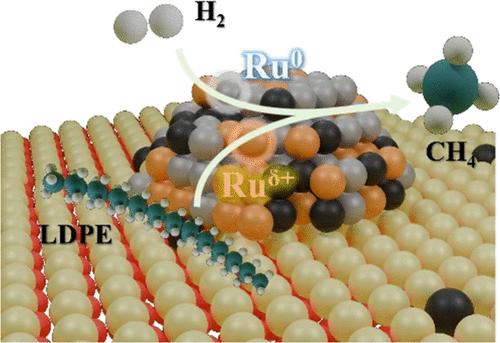Enhancing the Conversion Efficiency of Polyethylene to Methane through Codoping of Mn Atoms into Ru Centers and CeO2 Supports
IF 14.4
1区 化学
Q1 CHEMISTRY, MULTIDISCIPLINARY
引用次数: 0
Abstract
Chemical conversion has emerged as an effective approach for disposing waste plastics; however, the product diversity in traditional methods leads to pressing challenges in product separation and purification. As a pioneering advancement, the comprehensive transformation of waste plastics into CH4 presents an attractive prospect: directly yielding high-purity products. Significantly, CH4 is an important hydrogen carrier and an industrial feedstock. However, there is still much room for enhancing the overall efficiency. Herein, we show a new strategy to construct a high-efficiency and robust polyethylene (PE) upgrading catalyst by codoping Mn heteroatoms into both RuO2 and CeO2. We found that these Mn heteroatoms effectively bolster the stability of Ruδ+ species under high-temperature reduction conditions. The harmonious coexistence of Ru0 and Ruδ+ significantly refines the reaction pathway by enhancing the adsorption of the alkane intermediates. Consequently, we achieved an impressive PE conversion rate exceeding >99% with nearly 99% toward CH4 at a moderate temperature of 250 °C within 8 h. Our discovery not only opens a new window for catalyst upgrading but also presents exciting opportunities for the in-depth conversion of waste plastics into complex, high-purity fine chemicals through methane-mediated catalysis.

通过在 Ru 中心和 CeO2 支持物中掺入锰原子提高聚乙烯到甲烷的转化效率
化学转化已成为处理废塑料的一种有效方法;然而,传统方法中的产品多样性导致产品分离和提纯面临紧迫挑战。作为一项开创性的进步,将废塑料全面转化为 CH4 展示了诱人的前景:直接产生高纯度产品。重要的是,CH4 是一种重要的氢载体和工业原料。然而,在提高整体效率方面仍有很大的空间。在本文中,我们展示了一种新策略,即通过在 RuO2 和 CeO2 中共价掺杂杂原子锰来构建高效、坚固的聚乙烯(PE)升级催化剂。我们发现,在高温还原条件下,这些杂原子能有效提高 Ruδ+ 物种的稳定性。Ru0 和 Ruδ+ 的和谐共存增强了对烷烃中间产物的吸附,从而大大改善了反应途径。我们的发现不仅为催化剂升级打开了一扇新窗口,而且为通过甲烷介导催化将废塑料深度转化为复杂的高纯度精细化学品提供了令人兴奋的机遇。
本文章由计算机程序翻译,如有差异,请以英文原文为准。
求助全文
约1分钟内获得全文
求助全文
来源期刊
CiteScore
24.40
自引率
6.00%
发文量
2398
审稿时长
1.6 months
期刊介绍:
The flagship journal of the American Chemical Society, known as the Journal of the American Chemical Society (JACS), has been a prestigious publication since its establishment in 1879. It holds a preeminent position in the field of chemistry and related interdisciplinary sciences. JACS is committed to disseminating cutting-edge research papers, covering a wide range of topics, and encompasses approximately 19,000 pages of Articles, Communications, and Perspectives annually. With a weekly publication frequency, JACS plays a vital role in advancing the field of chemistry by providing essential research.

 求助内容:
求助内容: 应助结果提醒方式:
应助结果提醒方式:


